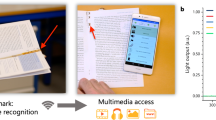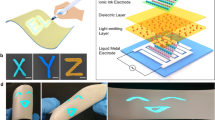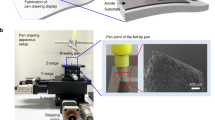Abstract
Paper and textiles that are commonly used in our daily lives hold great potential as platforms for next-generation flexible and wearable electronics. However, strategies for fabricating light-emitting diodes and photodetectors on different substrates are restricted in terms of their quantity and variety as strict flatness and smoothness are often required. Here we develop a highly versatile, scalable and eco-friendly handwriting approach to draw multicolour perovskite light-emitting diodes and perovskite photodetectors on various substrates, including paper, textiles, plastics, elastomers, rubber and three-dimensional objects. Our method uses common ballpoint pens filled with newly formulated inks of conductive polymers, metal nanowires and multiple perovskites for a wide range of emission colours. Just like writing with multicoloured pens, writing layer-by-layer with these functional inks enables perovskite optoelectronic devices to be realized within minutes. This process can be carried out by individuals without specialized training. The handwritten perovskite light-emitting diodes can exhibit a brightness as high as 15,225 cd m−2, a current efficiency of 6.65 cd A−1 and a turn-on voltage of 2.4 V. The perovskite photodetectors exhibit an on/off ratio of over 10,000 and a responsivity of up to 132 mA W−1. This work offers a route to the integration of perovskite optoelectronics in low-cost and large-area application scenarios such as electronic textiles, electronic paper, smart packaging and other disposable electronics and wearables.
This is a preview of subscription content, access via your institution
Access options
Access Nature and 54 other Nature Portfolio journals
Get Nature+, our best-value online-access subscription
$29.99 / 30 days
cancel any time
Subscribe to this journal
Receive 12 print issues and online access
$209.00 per year
only $17.42 per issue
Buy this article
- Purchase on Springer Link
- Instant access to full article PDF
Prices may be subject to local taxes which are calculated during checkout





Similar content being viewed by others
Data availability
All data supporting the results in this study are provided in the Article and Supplementary Information. Additional data are available from the corresponding authors upon reasonable request.
Change history
11 August 2023
In the version of this article initially published, an incorrect version of the Supplementary information appeared, which is now amended in the HTML and PDF versions of the article.
References
Liang, J., Li, L., Niu, X., Yu, Z. & Pei, Q. Elastomeric polymer light-emitting devices and displays. Nat. Photonics 7, 817–824 (2013).
Yu, Z., Niu, X., Liu, Z. & Pei, Q. Intrinsically stretchable polymer light-emitting devices using carbon nanotube–polymer composite electrodes. Adv. Mater. 23, 3989–3994 (2011).
Lien, D.-H. et al. Large-area and bright pulsed electroluminescence in monolayer semiconductors. Nat. Commun. 9, 1229 (2018).
Wang, C. et al. User-interactive electronic skin for instantaneous pressure visualization. Nat. Mater. 12, 899–904 (2013).
Chou, S. Y. et al. Transparent perovskite light-emitting touch-responsive device. ACS Nano 11, 11368–11375 (2017).
Gu, L. et al. A biomimetic eye with a hemispherical perovskite nanowire array retina. Nature 581, 278–282 (2020).
Gu, L. et al. 3D arrays of 1024‐pixel image sensors based on lead halide perovskite nanowires. Adv. Mater. 28, 9713–9721 (2016).
Rao, Z. et al. Curvy, shape-adaptive imagers based on printed optoelectronic pixels with a kirigami design. Nat. Electron. 4, 513–521 (2021).
Ershad, F. et al. Ultra-conformal drawn-on-skin electronics for multifunctional motion artifact-free sensing and point-of-care treatment. Nat. Commun. 11, 3823 (2020).
Lin, K. et al. Perovskite light-emitting diodes with external quantum efficiency exceeding 20 per cent. Nature 562, 245–248 (2018).
Wang, N. N. et al. Perovskite light-emitting diodes based on solution-processed self-organized multiple quantum wells. Nat. Photonics 10, 699–704 (2016).
Bade, S. G. et al. Fully printed halide perovskite light-emitting diodes with silver nanowire electrodes. ACS Nano 10, 1795–1801 (2016).
Kim, Y. H. et al. Exploiting the full advantages of colloidal perovskite nanocrystals for large-area efficient light-emitting diodes. Nat. Nanotechnol. 17, 590–597 (2022).
Zhu, M. et al. Electrohydrodynamically printed high‐resolution full‐color hybrid perovskites. Adv. Funct. Mater. 29, 1903294 (2019).
Zhao, J. et al. High-speed fabrication of all-inkjet-printed organometallic halide perovskite light-emitting diodes on elastic substrates. Adv. Mater. 33, 2102095 (2021).
Tsai, H. et al. Bright and stable light-emitting diodes made with perovskite nanocrystals stabilized in metal–organic frameworks. Nat. Photonics 15, 843–849 (2021).
Tian, Y. et al. Highly efficient spectrally stable red perovskite light-emitting diodes. Adv. Mater. 30, 1707093 (2018).
Fang, Y. J., Dong, Q. F., Shao, Y. C., Yuan, Y. B. & Huang, J. S. Highly narrowband perovskite single-crystal photodetectors enabled by surface-charge recombination. Nat. Photonics 9, 679–686 (2015).
Swarnkar, A. et al. Quantum dot-induced phase stabilization of α-CsPbI3 perovskite for high-efficiency photovoltaics. Science 354, 92–95 (2016).
Lei, Y. et al. A fabrication process for flexible single-crystal perovskite devices. Nature 583, 790–795 (2020).
Seo, H. K. et al. Efficient flexible organic/inorganic hybrid perovskite light-emitting diodes based on graphene anode. Adv. Mater. 29, 1605587 (2017).
Kim, T. H. et al. Full-colour quantum dot displays fabricated by transfer printing. Nat. Photonics 5, 176–182 (2011).
Pan, T., Liu, S., Zhang, L., Xie, W. & Yu, C. A flexible, multifunctional, optoelectronic anticounterfeiting device from high-performance organic light-emitting paper. Light Sci. Appl. 11, 59 (2022).
Zhu, H. L. et al. Biodegradable transparent substrates for flexible organic-light-emitting diodes. Energy Environ. Sci. 6, 2105–2111 (2013).
Gao, L. et al. Flexible, transparent nanocellulose paper-based perovskite solar cells. npj Flex. Electron. 3, 4 (2019).
Yoon, D. Y. & Moon, D. G. Bright flexible organic light-emitting devices on copy paper substrates. Curr. Appl. Phys. 12, e29–e32 (2012).
Choi, S. et al. Multi-directionally wrinkle-able textile OLEDs for clothing-type displays. npj Flex. Electron. 4, 33 (2020).
Kim, H., Kwon, S., Choi, S. & Choi, K. C. Solution-processed bottom-emitting polymer light-emitting diodes on a textile substrate towards a wearable display. J. Inf. Disp. 16, 179–184 (2015).
Shi, X. et al. Large-area display textiles integrated with functional systems. Nature 591, 240–245 (2021).
Dai, X. et al. Solution-processed, high-performance light-emitting diodes based on quantum dots. Nature 515, 96–99 (2014).
Chen, J. et al. Efficient and bright white light-emitting diodes based on single-layer heterophase halide perovskites. Nat. Photonics 15, 238–244 (2021).
Lei, Y. et al. Controlled homoepitaxial growth of hybrid perovskites. Adv. Mater. 30, 1705992 (2018).
Xing, G. et al. Low-temperature solution-processed wavelength-tunable perovskites for lasing. Nat. Mater. 13, 476–480 (2014).
Chen, X. M. et al. Solution-processed inorganic perovskite crystals as achromatic quarter-wave plates. Nat. Photonics 15, 813–816 (2021).
Bade, S. G. R. et al. Stretchable light-emitting diodes with organometal-halide-perovskite–polymer composite emitters. Adv. Mater. 29, 1607053 (2017).
Zhou, Y. et al. A universal method to produce low-work function electrodes for organic electronics. Science 336, 327–332 (2012).
Lo, L. W. et al. An inkjet-printed PEDOT:PSS-based stretchable conductor for wearable health monitoring device applications. ACS Appl. Mater. Interfaces 13, 21693–21702 (2021).
Acknowledgements
This work was partially funded by the Bill & Melinda Gates Foundation under award numbers INV-005417 and INV-035476 (J.Z., L.-W.L. and C.W.) and Washington University. We also acknowledge the Institute of Materials Science and Engineering at Washington University for the use of instruments and staff assistance.
Author information
Authors and Affiliations
Contributions
J.Z. and C.W. conceived the idea and designed the experiments. J.Z. carried out all the experiments including the ink development, device fabrication, characterization of the materials and device measurements. L.-W.L. contributed to part of the ink formulation and development of the printing process. J.Z., Z.Y., and C.W. performed the data analysis. J.Z. and C.W. wrote the paper while all authors provided feedback.
Corresponding authors
Ethics declarations
Competing interests
The authors declare no competing interests.
Peer review
Peer review information
Nature Photonics thanks Qibing Pei, Sheng Xu, Cunjiang Yu and the other, anonymous, reviewer(s) for their contribution to the peer review of this work.
Additional information
Publisher’s note Springer Nature remains neutral with regard to jurisdictional claims in published maps and institutional affiliations.
Supplementary information
Supplementary Information
Supplementary Figs. 1–16 and Tables 1–5.
Rights and permissions
Springer Nature or its licensor (e.g. a society or other partner) holds exclusive rights to this article under a publishing agreement with the author(s) or other rightsholder(s); author self-archiving of the accepted manuscript version of this article is solely governed by the terms of such publishing agreement and applicable law.
About this article
Cite this article
Zhao, J., Lo, LW., Yu, Z. et al. Handwriting of perovskite optoelectronic devices on diverse substrates. Nat. Photon. 17, 964–971 (2023). https://doi.org/10.1038/s41566-023-01266-1
Received:
Accepted:
Published:
Issue Date:
DOI: https://doi.org/10.1038/s41566-023-01266-1
This article is cited by
-
High brightness and low operating voltage CsPbBr3 perovskite LEDs by single-source vapor deposition
Scientific Reports (2024)
-
A rainbow of LEDs adorns objects at the stroke of a pen
Nature (2023)
-
Hand-drawing perovskite devices
Nature Photonics (2023)
-
Writing perovskite optoelectronic devices with ballpoint pens
Science China Materials (2023)



